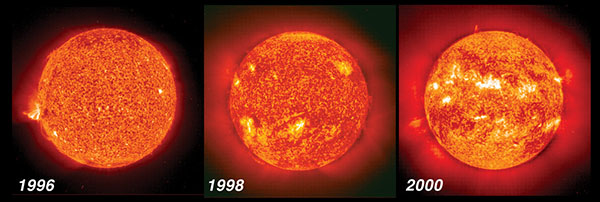
by Elaine Tu Thursday, January 5, 2012

These images, four years apart, show the rise and fall of solar activity during the sun's 11-year cycle. SOHO (ESA & NASA)
For the past few years, astronomers and scientists have been looking up at a sun that is, more often than not, rather blank. Almost too blank. That is, the sun has been relatively free of the dark patches, called “sunspots,” that appear within 30 degrees of the sun’s equator and travel across the surface. Although low sunspot counts are normal in a typical sunspot cycle, this period has gone on longer than usual, scientists noted at an international solar conference on “Solar Variability, Earth’s Climate and the Space Environment” held in early June at Montana State University in Bozeman. However, they said, while slightly longer than the past three or four solar cycles, the current minimum is not too out of the ordinary.
The low number of sunspots means that the sun’s magnetic activity is also low, because sunspots are areas of the sun with particularly strong magnetic fields. The magnetic fields inhibit heat transport to the surface, creating cooler patches that look darker than their surroundings. As the sun becomes more magnetically active, the number of spots increases. Solar activity is associated with solar flares and ejections, which can affect satellites and communications on Earth.
Usually, the number of sunspots rises, peaks and falls within a span of approximately 11 years, called the “sunspot cycle.” Sunspots often appear in horizontally oriented pairs; one spot has a north magnetic field, and the other has a south magnetic field. Those polarities help identify the beginning of a new cycle, because new solar cycles always start with reversed polarity sunspots, says David Hathaway, a solar physicist at NASA’s Marshall Space Flight Center in Huntsville, Ala.
Scientists keep track of the cycles by numbering them at the beginning of each minimum, a practice that started in the mid-1700s. The present cycle, Solar Cycle 24, officially began on Jan. 24, 2008, when a south-north oriented pair of sunspots appeared where there had previously been only north-south oriented pairs. Our current solar minimum is the transition period.
The number of Cycle 24 spots has been increasing slowly. “This is one of the quietest and longest minima,” says Dan Baker, director of the Laboratory for Atmospheric and Space Physics at the University of Colorado at Boulder.
Although the latest minimum appears to be longer than its most recent predecessors, it is not the sun’s longest minimum. In fact, out of the 23 completed solar cycles observed by scientists since the 1700s, “there are still six cycles that have been longer than the one we’re trying to finish,” says Douglas Biesecker, a solar physicist from NOAA’s Space Weather Prediction Center in Boulder, Colo. So far, despite being slightly lower than predicted, the observed sunspot count has not deviated significantly from the numbers expected from Cycle 24.
© 2008-2021. All rights reserved. Any copying, redistribution or retransmission of any of the contents of this service without the expressed written permission of the American Geosciences Institute is expressly prohibited. Click here for all copyright requests.